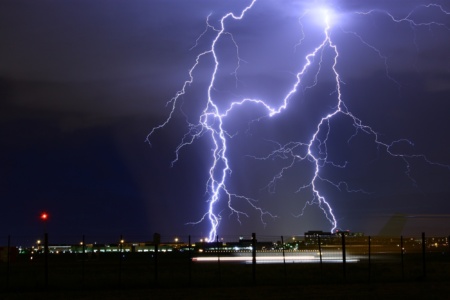
During a powerful thunderstorm in the Swiss Alps, researchers were able to control lightning strikes with a laser for the first time.

Lightning is a powerful electrical discharge between clouds or between clouds and the ground. The temperature of the charge reaches 30,000°C, which is five times hotter than the Sun. About 100 lightning strikes the Earth every second, and more than a billion of them will be collected in a year. Lightning not only causes tens of billions of dollars in destruction and damage, but also causes thousands of deaths.
Traditional lightning rods have been used since the mid-18th century, when Benjamin Franklin first conducted his famous kite experiment, and then scientists began to look for more effective ways to protect buildings and objects from destructive strikes.
In an article for the journal Nature Photonics, researchers from Switzerland describe their experiment using a powerful laser. The device, the size of a car, was brought to the top of Mount Sentis in northeastern Switzerland and “parked” next to a 124-meter telecommunications tower, which is struck by lightning about 100 times a year.
Course
CFO
Become an experienced director-level finance specialist!
REGISTER!

The researchers waited for stormy weather, and in the period from July to September of last year, they “shot” the clouds with fast laser pulses for 6 hours. Instruments set up to record lightning strikes showed that during the experiments, the laser changed the course of four ascending lightning discharges.
Only one strike, on July 21, occurred in clear enough conditions for researchers to capture the lightning’s path on both sides using high-speed cameras located several kilometers away. The footage shows the lightning moving the laser beam about 50 meters, suggesting that the pulses helped guide the strike.
The laser deflects lightning strikes, creating an easier path for the electrical discharge. As the laser pulses are directed into the sky, the change in the refractive index of the air causes them to compress and become so intense that they ionize the air molecules around them. This results in a chain of “threads in the sky” where air molecules are rapidly heated and move at supersonic speeds, leaving a channel of low-density ionized air. These channels, which last for milliseconds, are more electrically conductive than the surrounding air and thus form an easier path for lightning to travel.
More powerful lasers operating at different wavelengths can direct lightning over long distances and even trigger it before it becomes a threat. In subsequent experiments, the researchers plan to extend the range of the laser so that the effective coverage of the 10-meter rod is 500 meters.
Scientist Matteo Clerici from the University of Glasgow told The Journal that the laser used in the experiment costs about 2.17 billion dollars.
“The cost of the laser system is very high compared to the cost of a simple metal rod (lightning rod). However, lasers may be a more reliable way of directing electrical discharge, and this may be important for protecting critical ground installations and equipment,” said Professor Manu Haddad, director of the Morgan-Botti Lightning Laboratory at Cardiff University.
The technology would be particularly useful for protecting missile launch sites, where lightning strikes can delay missions, as well as protecting airports, power plants, forests and other industries where lightning can cause catastrophic consequences.
Source: Engadget, The Guardian




